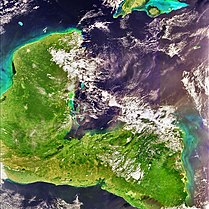
Back Federale Republiek van Sentraal-Amerika Afrikaans جمهورية أمريكا الوسطى الاتحادية Arabic República Federal d'América Central AST مرکزی فدرال آمریکا جومهوریتی AZB Злучаныя Правінцыі Цэнтральнай Амерыкі Byelorussian Федерална република Централна Америка Bulgarian Proviñsoù Unanet Kreizamerika Breton Províncies Unides de l'Amèrica Central Catalan Federativní republika Střední Ameriky Czech Gweriniaeth Ffederal Canolbarth America Welsh
This article or section is in a state of significant expansion or restructuring. You are welcome to assist in its construction by editing it as well. This template was placed by PizzaKing13 ¡Hablame! 03:52, 15 April 2024 (UTC). If this article or section has not been edited in several days, please remove this template. If you are the editor who added this template and you are actively editing, please be sure to replace this template with {{in use}} during the active editing session. Click on the link for template parameters to use.
This article was last edited by [[User:|]] ([[User talk:|talk]] | contribs) 0 seconds ago. (Update timer) |
This article needs additional citations for verification. (October 2016) |
Federal Republic of Central America República Federal de Centro América | |||||||||||||||||||
|---|---|---|---|---|---|---|---|---|---|---|---|---|---|---|---|---|---|---|---|
| 1823–1839/1841 | |||||||||||||||||||
| Motto: Dios, Unión, Libertad "God, Union, Liberty" | |||||||||||||||||||
| Anthem: La Granadera "The Grenadier" | |||||||||||||||||||
 An orthographic projection of the world with the Federal Republic of Central America in green and its uncontrolled territorial claims in light green | |||||||||||||||||||
| Capital | Guatemala City (until 1834) Sonsonate (1834) San Salvador (from 1834) | ||||||||||||||||||
| Common languages | Spanish and various indigenous languages | ||||||||||||||||||
| Religion | Catholicism | ||||||||||||||||||
| Demonym(s) | Central American | ||||||||||||||||||
| Government | Federal presidential republic | ||||||||||||||||||
| President | |||||||||||||||||||
• 1825–1829 | Manuel José Arce (first) | ||||||||||||||||||
• 1830–1834, 1835–1839 | Francisco Morazán (last) | ||||||||||||||||||
| Legislature | Federal Congress[a] | ||||||||||||||||||
| Senate | |||||||||||||||||||
| Chamber of Deputies | |||||||||||||||||||
| Historical era | Spanish American wars of independence | ||||||||||||||||||
• Independence from the Spanish Empire | 15 September 1821 | ||||||||||||||||||
• Independence from the First Mexican Empire | 1 July 1823 | ||||||||||||||||||
• Constitution adopted | 22 November 1824 | ||||||||||||||||||
• Dissolution | 17 April 1839 | ||||||||||||||||||
• El Salvador declares its independence | 30 January 1841 | ||||||||||||||||||
| Area | |||||||||||||||||||
• Total | 200,000 sq mi (520,000 km2) | ||||||||||||||||||
| Population | |||||||||||||||||||
• 1824 | 1,287,491 | ||||||||||||||||||
• 1836 | 1,900,000 | ||||||||||||||||||
| Currency | Real | ||||||||||||||||||
| |||||||||||||||||||
| Part of a series on |
| Central America |
|---|
 |
The Federal Republic of Central America (Spanish: República Federal de Centro América), originally known as the United Provinces of Central America (Provincias Unidas del Centro de América), was a sovereign state in Central America which existed from 1823 to 1839. The federal republic was composed of five states: Costa Rica, El Salvador, Guatemala, Honduras, and Nicaragua. The federal republic was bordered to the north by Mexico, to the south by Gran Colombia, and on its eastern coastline by the Mosquito Coast and British Honduras.
Shortly after Central America, then known as the Captaincy General of Guatemala, declared its independence from the Spanish Empire in September 1821, it was annexed by the First Mexican Empire in January 1822 before regaining its independence and forming a federal republic in 1823. The Federal Republic of Central America adopted its constitution, which was based on the federal government of the United States, in November 1824. It held its first presidential election in April 1825, during which, liberal politician Manuel José Arce was elected as the country's first president. Arce subsequently aligned himself with the country's conservatives as the liberals opposed the concessions he granted to conservatives to secure his election as president. From 1827 to 1829, the country fell into civil war between conservatives who supported Arce and liberals who opposed him. Liberal politician Francisco Morazán ultimately led the liberals to victory and was elected president in 1830. The federal republic descended into a second civil war from 1838 to 1840, by the end of which, the states of Central America declared their independence and the federal republic ceased to exist.
The federal republic was very politically unstable, suffering several civil wars, rebellions, and insurrections between liberals and conservatives. Historians have attributed the country's political instability to its federal system of government and its economic struggles. Agricultural exports were unable to raise sufficient funds and the federal government was also unable to repay its foreign loans despite favorable terms. Central America's economic troubles were caused in part due to the federal government being unable to collect taxes and a lack of efficient interstate infrastructure.
Since the dissolution of the federal republic, there have been several attempts to reunify Central America during the 19th and 20th centuries through both diplomatic and military means. All these attempts eventually failed, and the Federal Republic of Central America remains the only successful united Central American state.
- ^ Karnes 1961, p. 35.
Cite error: There are <ref group=lower-alpha> tags or {{efn}} templates on this page, but the references will not show without a {{reflist|group=lower-alpha}} template or {{notelist}} template (see the help page).
© MMXXIII Rich X Search. We shall prevail. All rights reserved. Rich X Search

